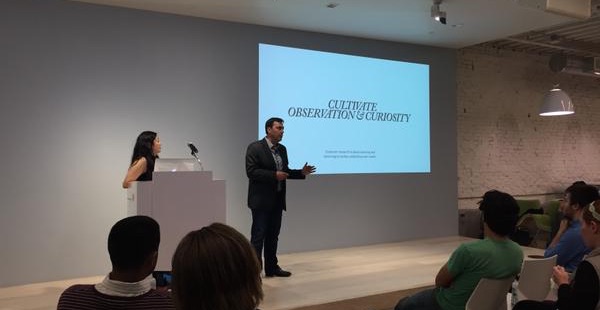David Doss was kind enough to share his notes from Skye Lee & Blaise Bertrand's talk Design for Empathy and Retention.
Overview
- “We are all agents of change. We need to find the way that we can do this.”
- IDEO: Human-Centered Innovation
- Blaise Bertrand (Partner and Industrial Director)
- Design can make people happy or sad
- Improve or hinder human connection
- Skye Lee (UX + Product)
- Adviosry
- “When you are working in industry, friendship doesn’t really develop naturally.”
Video
- understand the non-obvious needs that people have
- human truths – getting to core of issue by understanding and empathisizing for what people need
- making sense of cutting through the noise, getting to the essentials, making it a beautiful experience
- building to learn: using tools to express ideas as tangible
- what will delight people, find technology / business model for that to happen
Hospital redesign
- Christian got into emergency room, and filmed the entire experience
- Video of the ceiling
- Faked an injury in order to get into the hospital
- EMPATHY – note people:
- What they SAY
- What they DO
- What they THINK
- What they FEEL
- Reconciling all of the above
Tech PUSH versus tech PULL. IDEO aims for push.
Examples
- Moto
- speeds
- iteration
- feedback loops
- second-best-selling accessory for Motorola
- Emotiv Epoc:
- controlling robot with thoughts
- being able to drive car with device
- Steelcase Node Chair
- mobile chair
- redesigning chair can change dynamics and way that people learn
- Joie De Vivre Hotel
- mixing art and tech to create emotional interactions
Designing for massive transitions
- transportation industry
- shifting / complementing hardware and software
- Ford Hybrid:
- Have to start thinking about new behaviors and life changes
- How to recognize driving efficiently?
- Image of leaves growing
- Using analogies to create meaning
Reconnecting with sense of purpose and communicating it
- Findus
- Understanding people internally
- What is their passion? learn how to communicate it better
Open IDEO
- post challenges
- collect ideas (crowd research inspiration)
- the more visual the posts, the better
- stories will help people get going
- refinement
- encourage people to build ideas
- create opportunity
- everyone can take various ideas that work and move them more fully forward
- analysis
- the more ideas you build, and the more fully you do so, the better
- design quotient
- inspiration
- conceptualization
- evaluation
- collaboration
Provoking new conversation vs. stealing ideas
- inherent generosity in design innovation
- avoid fear of sharing
- anyone can come up with ideas
- bringing ideas to market is a completely different thing
- productization
- paranoia will prevent you from moving forward
- dialogue
- no need to be afraid
- exchange – even if people take something from your idea, you will also take something from their ideas
- by the time you get a patent, the moment can be gone
- (certainly depends on individual situation, and the specific industry)
- if you have nothing, what do you have to lose?
- Examples:
- IDEO’s Start up in residence program
- Financial view: ROI (return on investment) vs. ROL (return on learning). Looking at cues – understanding the surrounding
Summary
- FAIL EARLY; FAIL FAST; FAIL BIG
- get assumptions out early
- UNDERSTAND THE HARDWARE AND THE SOFTWARE
- Understand the differences in cultures and processes between the two different groups
- Brand; offer / experience; organization; business
- Dive deep, but check against the whole
- System for embracing failure
- Failing is hard
- Need system where it is ok to recuperate from failure
- Answer: build a network
- Seek mentorship
- Build network
- Creative collisions: broad and radical collaboration
- Exercising hybrid rigor
- Quantitative and quantitative methods to get results
- Compare and contrast results
- Learn through building:
- BUILD IT IN CONTEXT
- Real scale
- Measure behaviors
- Don’t take yourself too seriously – most importantly, have fun
Takeaways from Q&A
- Creativity in software:
- Careful: risk impoverishing our senses
- How to develop radical ideas:
- Not necessary
- Why do you need a “house on fire” problem?
- Just start listening to the problems around you
- T-shaped career profile
- Master one thing, and then extend
- Start with sense of purpose
- (generalizing specialist / versatilist / technical craftsperson / renaissance developer / master generalist)
- how to go about redesigning meetups?
- Participation, collaborative
- Break in and ask participants what they want.
- How to manage a startup with physicians who are very resistant to change and immersed in bureacracy?
- Bring several people on board
- Movement
- Talk to them about what they will gain
- Learn their communication culture
- How to work with it
- How to think beyond it
- Example: Develop a written superpowers exercise: Get them into an orientation: I need to get you to solve a problem
- How should I “make it big” in tech?
- There is nothing richer than the interactions that I have right in front of me
Filmed March 19, 2015 at Zendesk



